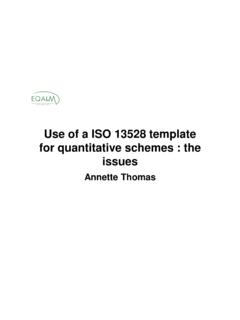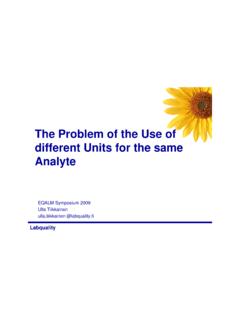Transcription of External Quality Assessment in Medical …
1 & quot ; External Quality Assessment in Medical laboratories & quot ; - differences with other PT testing programs JC Libeer Brussels, Belgium EQA versus PT. The term PT in laboratory medicine is commonly used in North America Proficiency testing (PT) focus essentially on laboratory performance evaluations especially for regulatory purposes From EQAS to EQAP. EQAS: External Quality Assessment Schemes EQAP: External Quality Assurance Programs Olafsdottir E, Hellsing K, Steensland H, Terhunen R, Uldall A. Adding new scopes to traditional EQA schemes emphasizig Quality improvement. Upsala J Med Sc 1994: 187- 187-183. EQAP. EQAP is an interlaboratory comparison designed and operated to assure one or more of following aspects: Participant performance evaluation (analytical performance, test interpretation, advice to the clinician on laboratory requests and on diagnosis Vigilance of IVD's Continuous education, training and help The primary intention of the activities of an EQAP in laboratory medicine shall be to support Quality improvements of the service provided by participating laboratories for the benefits of the patients.)
2 (IFCC Guidelines for the Requirements for the Competence of EQAP. organizers 2002). Interlaboratory comparison ISO 15189. The laboratory shall participate in interlaboratory comparisons such as those organized by External Quality Assessment schemes. Laboratory management shall monitor the results of External Quality Assessment and participate in the implementation of corrective actions when control criteria are not furfilled. Interlaboratory comparison shall be in substantial agreement with ISO/IEC. Guide 43- 43-1. External Quality Assessment programmes should, as far as possible, provide clinically relevant challenges that mimic patient samples and have the effect of checking the entire examination process, including pre- pre- and post post--examination procedures. Patient care in ISO.
3 15189 . Introduction: Medical laboratory sevices are essential to patient care . : Medical laboratory services, including appropriate interpretation and advisory servies, shall be designed to meet the needs of patients and all clinical personnel responsible for patient care Patient care in ISO. 15189 . : Laboratory management shall implement Quality indicators for systematically monitoring and evaluating the laboratory's contribution to patient care .. care .. Laboratory management shall ensure that the Medical laboratory articipates in Quality improvement activities that deal with relevant areas and outcomes of patient care Patient care in ISO. 15189 . : The internal audit shall progressively address these elements and emphasize areas critically important to patient care : In order to ensure their continuing suitability and effectiviness in support of patient care.
4 I) Quality indicators for monitoring the laboratory's contribution to patient care Patient care in ISO. 15189 . : The Quality and appropriateness of the laboratory's contribution to patient care shall, to the extent possible, be monitored and evaluated objectively. : The laboratory shall have space allocated so that its workload can be performed without compromising the Quality of work, Quality control procedures, safety of personnel or patient care services Patient care in ISO. 15189 . : Reporting of results: e) Date and time of primary sample collection, when available and relevant to patient care, care, and time of receipt by the laboratory The laboratory shall have procedures for immediate notification of a physician (or other clinical responsible for patient care).
5 Care). when examination results for critical properties fall within established alert or critical intervals. Patient care in ISO. 15189 . Laboratory management, in consultation with the requesters, shall establish turnaround times for each of its examinations. A turnaround time shall reflect clinical needs.. This does not mean that the clinical personnel are to be notified of all delays in examinations, but only in those situations where the delay could compromise patient care. care. Patient care in ISO. 15189 . Annex B: Recommendations for protection of laboratory information systems (LIS). Reference to patient care 4X. EQA/PT ORGANIZERS. Medical laboratories Other type of laboratories Professional International and organisations national scientific Scientific societies organisations (institutions).
6 Governmental organisations Commercial organisations IVD manufacturers Accreditation bodies Professional & Scientific EQA organizers versus commercial EQA organizers Is there a specific role to play by professional and scientific EQA. organisations? Is there a specific role to play by IVD. manufacturers organizing EQA schemes? EQA from IVD. manufacturers (1). Organizer of regular EQA schemes with several materials Link with the producer of kits and reagents Extra service for users of the same internal QC material Only own QC materials are used No real patient material EQA from IVD. manufacturers (2). Especially activity in clinical chemistry and immunoassays Large groups, in general good service Free participation Educational, no sanctions Feedback from a steering committee (expert board) ?
7 THESE SCHEMES FOCUS ON ANALYTICAL. Quality . Non-commercial EQA. Non- schemes PT schemes External Quality Assessment =>. Mandatory External Quality Linked to a licence assurance schemes Can be mandatory or free Repressive (sanctions) Can be linked to a license Acceptability limits Essentially educational based on state of the Dynamic: incentives for art Quality improvement tools Static: no incentive for for problem related schemes Quality improvement (EQAP approach). Follow--up: the bad Follow and the good boys . Inconvenience of PT. schemes Bad boys are punished Everybody is happy with the good boys . But: are the good boys as good as they look? Impression of the potential capability of laboratories to perform these tests No link with patient samples analysis EQAP covers more than EQA.
8 Participant performance evaluation Method performance evaluation Contineous education tool Analytical performance and clinical outcome evaluation Support for internal QC. Training & help Promotion of standardisation efforts Quality improvement of patient results &. interpretation .. EQAP covers more than EQA: new item of interest External Quality Assurance Programs Broad panel of schemes covering all aspects of laboratory medicine - Preparation of own control materials Or - Sharing sample preparation - Attention for new fields, new tests - Fields for which there is no interest from commercial organizers External Quality Assurance Programs MUST FOCUS ON CLINICAL OUTCOME AND. NOT ONLY ON ANALYTICAL RESULTS. Including pre- pre- and post analytical EQA. Including difficult samples Mimic as much as possible patient samples Attention for Quality management of new applications ( POCT, NPT).
9 Acceptability limits may be based on EBM, biological requirements,.. Pre-analytical EQA: Pre- examples Examination of sample deficiencies based on data from participants (SEQC experience). EQA on appropriate sample package Paper challenges with a clinical case and evaluation of an appropriate tests request Distribution of not appropriate sample material (these samples are expected not to be analysed). Preanalytical Quality control program . an overview of results (2001. (2001 . 2005 summary). 105 laboratories : tubes ( %). REJECTS. EDTA/SERUM ( of all samples) % of all rejects 81% of rejects due to : Specimen not received HEMOLYSIS = samples ! Clotted sample About 30% of ALL rejects due to HEMOLYSIS. Cec lia Mart nez- Mart nez-Br et al. Clin Chem Lab Med (2008);. 46. 46,, 6; 849.)
10 849 854 (SEQC). Paper Challenge of Accessioning Practices A nasal swab is submitted to the laboratory with clinical information possible anthrax . No other information provided. What action would your laboratory undertake with this sample? Set--up and Culture. Set 22%. A. Read at 24 hours. Do not process. 0%. B Destroy swab. Report: Do not perform this test . Do not process. 34%. C Contact physician. physician. Do not process. Seal for public health. Contact 78%. D Public Health. CMPT M013; November 2001. Example of educational EQAS. Cyclospora cayetanensis: 1997 1998 2000. N labs 255 263 239. Cyclospora 135 214 192. ( ) ( ) ( ). No parasites 52 10 18. found ( ) ( ) ( ). Results in the Belgian EQAS programmes Appropriate EQA material Performances of lyophilized materials do not always reflect performances in patient samples Some materials are scarce (IgM.)


